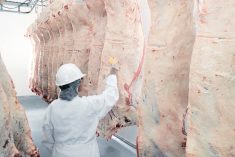During the last week of November, Alberta packers were buying fed cattle on a live basis at $243-$244 per hundredweight, f.o.b. feedlot in southern Alberta.
The fed market has been relatively flat over the past month. The Canadian slaughter has been running below year-ago levels but the year-over-year increase in fed cattle exports has kept feedlots current with production.
Market-ready fed cattle supplies are expected to increase in December and January, which will weigh on the Alberta basis. Lacklustre Canadian consumer spending has resulted in softer domestic demand; however, U.S. grocery store and restaurant spending has been higher than expected.
Read Also

Gentle treatments for pain in the neck
Heading toward year-end, people unknowingly tense up against the cold and busyness, causing neck pain that can often be treated with appropriate support and gentle mobility, athletic therapist Kathlyn Hossack says.
Alberta break-even pen closeout prices are in the range of $255-$259/cwt, so feedlot margins are struggling in red ink. At the time of writing this article, Charolais-cross steer calves weighing 800 lbs. were quoted at $370/cwt in central Alberta. Across Western Canada, quality 500-lb. steer calves are fluctuating between $500 and $525/cwt. The feeder market has many variables to digest over the next six months which will likely result in higher values. The outlook for feeder cattle has changed from our previous issue.
Cattle on feed in Alberta and Saskatchewan, as of Nov. 1, totalled 1,031,099 head, down six per cent or 67,510 head from the Nov. 1, 2023 figure of 1,098,609 head. The lower on-feed number was expected — and don’t take this as a bullish signal.
Placements during October were 376,406 head, up five per cent or 18,697 head from the October 2023 placements of 357,709 head. Placements weighing 900 lbs. and higher were 85,761 head, up 31,646 from last year. Given the placement data on the past four Cattle on Feed reports, market-ready supplies in Alberta and Saskatchewan are expected to be up about 15,000 head from year-ago levels during December and January. This is bearish for the Alberta basis for January and February.
U.S. cattle on feed for slaughter, as of Nov. 1, totalled 11.986 million head. This was up 0.3 per cent or 30,000 head from the Nov. 1, 2023 number of 11.956 million. Placements during October were 2.286 million head, up 116,000 head or five per cent from the October 2023 placement figure of 2.17 million. U.S. market-ready supplies of fed cattle are expected to be up 20,000-30,000 head for each month from December through February. U.S. cattle are being fed about one month longer than normal, resulting in heavier carcass weights.
Canadian beef demand has been struggling due to a debt-ridden, cash-strapped consumer. The average Canadian is struggling financially from month to month and overall consumer spending has decreased. In the U.S., we’ve seen a unique situation develop. Per-capita consumer spending has actually increased as wages continue to increase and inflation comes down.
McDonald’s stock reached up to US$317 in October, which was a historical high. This is a very strong indicator or barometer for beef demand. More importantly, U.S. monthly grocery store spending was up only one per cent from year-ago levels in September. This surged to a four per cent year-over-year increase in October, which is followed by two months of seasonally strong beef demand during November and December. It’s important to note January and February are two months of seasonally low demand.
New developments
In our previous issue, we were expecting the feeder market to soften during the first quarter of 2025. The outlook has changed.
On Nov. 22, the U.S. closed its border to Mexican feeder cattle after New World screwworm was found near the Mexico-Guatemala border. Talk in the trade is that it could take three or four months for procedures and protocols to be designed and implemented so trade will resume. The U.S. imports about 1.2 million head of Mexican feeder cattle each year, in quantities pretty evenly split between each quarter.
Secondly, U.S. winter wheat conditions were rated 55 per cent good to excellent at the end of November. We’re expecting to see a year-over-year increase in cattle grazing on small-grain pasture this winter.
While margins are in negative territory in the short term, feedlots in Alberta and Kansas both had a favourable margin structure for the summer of 2025. This is based on current feeder cattle prices, feed grain values and deferred fed cattle prices. The calf market has a price floor in place for the time being.
For Canadian producers, the Canadian dollar has deteriorated by three U.S. cents since September, which has enhanced feeder cattle prices. Longer-term, there was no significant heifer retention in 2024. We’re expecting Canadian and U.S. cow-calf producers to start heifer retention in the summer of 2025.
In conclusion
The fed cattle market has to contend with a year-over-year increase in market-ready fed cattle supplies during a period of seasonal low consumption. The feeder market has potential to divorce from the fed cattle market. The timeline for the resumption of feeder cattle trade out of Mexico is uncertain.
This will enhance U.S. demand for Canadian feeder cattle. The weaker Canadian dollar, along with the positive feeder margin structure for the summer of 2025, has set a price floor on the feeder complex for the time being.
















